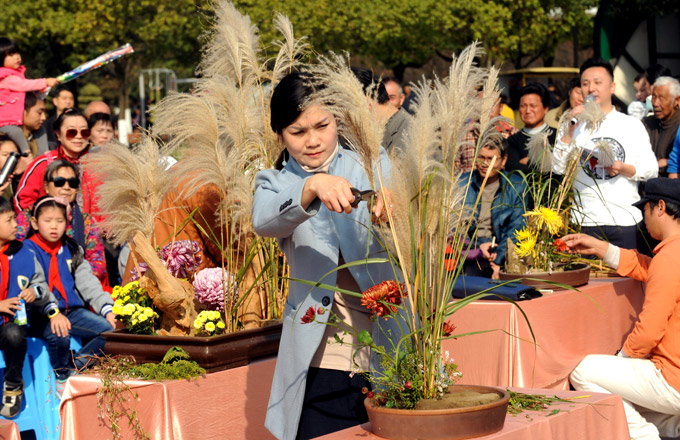

|
Shanghai Volkswagen debuts Lavida, its fi rst Volkswagen-branded vehicle designed by the Chinese, made in China and tailored for China's market, in May this year. |

There are still a few people that confuse Santana and Volkswagen. In their minds, Santana and Volkswagen are simply one and the same. Most people misunderstood this in China before the turn of the century.
It's clear that Santana, the iconic model of Shanghai Volkswagen Co Ltd (SVW), the first car-making joint venture in China after the country opened to the rest of the world, became the symbol of sedans in China's auto industry.
Besides being the first car from an auto joint venture, the Santana also ranked number one in sales volume last year, keeping its position on the top of the market, a place it has occupied for years.
The low-profile sedan has been also the model of choice for many Chinese drivers. Not only has it been in the market for a long time, but it also is the car that most Chinese people use to learn to drive. It is dubbed Pusang in Chinese.
The cars have been popular in China for decades even though the model has faded in western countries.
It is still the most popular sedan in some second and third-tier cities as an "evergreen car". However, in Germany its domestic market the total number of Santanas sold stood at 130,000 units.
Obviously, no other vehicle like Santana saw the development of China's auto industry, the same as its parent SVW.
A discussion for six years
Actually, Santana's local production can be attributed to a Chinese independent auto brand in Shanghai.
Early in 1978, Rao Bin, the late vice-minister of the First Machine-building Industry, suggested that an auto assembly line should be set up in Shanghai because the city was one of the leading auto production bases in China, producing Shanghai sedans.
The city promptly caught hold of the opportunity to start up a sedan project in July, and two months later it got permission from the State to discuss a sedan joint venture with foreign automakers, after Yu Qiuli, vice-premier of that time approved the proposal on introducing sedan production technologies and rebuilding the Shanghai Sedan Plant. The proposal changed China's auto industry.
The report suggested that China should enhance its auto production level by introducing the latest foreign technologies, which could be used in Shanghai to make Shanghai Sedan Plant a modern auto production base.
From 1958 when Shanghai developed its first sedan Fenghuang (Phoenix) to 1978, the Shanghai Sedan Plant never stopped producing the motor vehicle, but it always had a low capability and low production. It usually only produced several hundreds of motor vehicles a year and no more than 3,000.
Not like today's advanced robotic production and assembly line, in 1978 the Shanghai sedan was produced with simple tools such as hammers.
In November 1991 when production of the Shanghai sedan was stopped, the total number of the city's proud brand was only 11,000 cars, while today SVW produces more than 400,000 sedans per year.
Initially, after global automakers saw the Shanghai Sedan Plant, they lost interest because the size of China's sedan industry was too small.
But during further discussions, US General Motors' suggestion to build a joint venture received support from Deng Xiaoping, the chief architect of China's reform and opening-up policy as well as vice chairman at the time.
In 2002, when Chinese President Jiang Zemin visited Volkswagen's headquarters in Germany, a Xinhua news report said that Jiang actually paid his first visit to the headquarters in 1978. At that time, he was an official with the machine-building ministry.
Jiang reviewed the German auto industry and came up with the idea of introducing Volkswagen technologies in China.
When Jiang became Shanghai mayor in 1985, he provided guidance and helped support the SVW plan.
According to the memoirs of Jiang Tao, the principal of the Shanghai sedan project, also known as the Father of Santana, he recalled that when Jiang Zemin came up with the idea of a joint venture, Volkswagen reacted very actively saying, "if China would like to cooperate, Volkswagen will not only transfer the technologies but also with pleasure provide part of the capital".
After they returned to China, Volkswagen sent a team to Shanghai to research the Shanghai Sedan Plant then started the discussions, which lasted six years.
Just walking out of the 10-year "cultural revolution" (1966-76), there was no integrated law system to follow in China, especially for business.
Furthermore, although in 1979 the Chinese government started to permit ownership of private automobiles, in the early 1980s, owning a bicycle was still a luxury for the most Chinese people. With a salary of less than 50 yuan per month, nobody dared to dream of someday owning cars costing hundreds of thousands of yuan.
"We want to start with the annual production of 150,000 units, however, China plans to assemble the imported auto components by domestic cheap labor for the sake of exporting complete vehicles to acquire foreign exchange in urgent need," says Carl H Hahn, the former chairman of the board of Volkswagen in his memoirs.
To test the production cooperation, the two parties eventually agreed to assemble 30,000 of Volkswagen's sedans in Shanghai first.
"For me, it should be a significant strategy to tap into China, the market with the most potential in the world, although at that time, the popularization of private sedans in the nation was far behind Nigeria - where one in 2,500 people owned a sedan. Moreover, in terms of average purchasing power, the threshold of owning private sedan is that the average per capita income of the country should reach $4,000 annually, which China was still far behind," says Hahn.
"However, China's 5,000 year history and its reform and opening up policy persuaded me and my colleagues."
After signing a contract in 1982, the first Volkswagen auto Santana rolled off the assembly line a year later in Anting on the northwest outskirts of Shanghai.
|
The first Santana assembled in Shanghai Sedan Plant in 1983. |
The birth of a joint venture
In May, 1984, Li Peng, then-vice premier, paid a visit to Wolfsburg, Volkswagen's headquarters during an official trip to Germany.
"I saw two most advanced assembly lines controlled by computers, with the capability to assemble 600 units of vehicles per day and I test rode an Audi driven by Hahn at a speed of 175 km per hour. Hahn stressed to me his confidence in cooperating with China," Li said.
"(Li) promised before he left our headquarters that we would sign the joint venture contract in October," said Hahn.
Li's visit sped up the negotiations and in October, during German Premier Helmut Kohl's visit to China, the joint venture contract between Shanghai Automotive Industry Corp and Volkswagen was eventually signed, under a term of 25 years.
"The 50-50 investment measure and most terms in the SVW contract later became the main items in China's joint venture law and is continued to be used by most ventures today," Zhang Suixin, executive vice-president of Volkswagen Group China tells China Business Weekly.
"The birth of SVW put an end to China's history of making cars behind closed doors at a low technical level and blazed a path of utilizing foreign capital and introducing overseas technology for an accelerated development of the Chinese car making industry," says Zhang.
However, the shabby equipment and backward technology caused lots of doubt when Shanghai Volkswagen planted the seeds of China's modern car industry in farmlands located in the Shanghai outskirts of Anting town.
A reporter from the German Mirror Weekly ruthlessly affirmed: "to produce cars in a ruined, unsupported and isolated island, the experiment is doomed to fail".
The poor situation caused workers to fight. Shanghai Volkswagen's engineers produced the first car with two benches for rails and an assembly line in an incredibly crude workshop. Strong hands lifted the huge body of Santana and bore the weight of new hope in the Chinese auto industry.
Today, Anting draws a resplendent picture of the modern Shanghai Volkswagen plant, dotted with blue and white workshops.
When the reporter from the German Mirror Weekly visited again, he described it as "surprising" and "incredible".
After former German Chancellor Gerhard Schroeder visited Shanghai Volkswagen in November 1999, he said: "Shanghai Volkswagen is the successful apotheosis for the Sino-German cooperation".
A car to start the industry
Looking back at the auto industry in China, there was a lot of cooperation between nearly all of the world's giants. Shanghai Volkswagen, as the first baby and joint venture enterprise raised by China and German after reforms, had no existing experience to refer to, but it provided a starting point for the Chinese auto industry to follow and SVW's success has greatly promoted the growth of the Chinese auto-manufacturing industry.
While expanding its production scale, SVW started the Santana localization endeavor to revitalize the Chinese parts supply industry. When Santana first came to Shanghai, SVW found that there were no parts plants that could support them in the country, all production lines needed to be reconstructed; thousands of car parts except tires, radios and tape decks, speakers, antennas, and logos, depended on imports, and the localization rate was only 2.7 percent.
Under the circumstances, the entire project could have been defeated by high tariffs and the cost of CKD accessories.
SVW's drive to get parts made in China also began to clear the way for the entire Chinese auto industry.
They stuck by the principle of the "China Brand" and "no substitutions", and established an institution that regularly met to localize Santana and the domestic supplies rate eventually rose from 2.7 percent to its current 98.9 percent.
Now SVW has built the auto parts support network in China. There are now 400 members throughout 20 provinces and cities in the country.
SVW is not the only winner, its actions also established the base of China car parts industry.
New model to go further
In April 2002, the shareholders of SVW signed an agreement to extend the contract for another 20 years till 2030.
In 2003, the company celebrated its 2 millionth car driving off the assembly line.
On July 5, 2005, the 3 millionth SVW-made car rolled off the line, making SVW the first carmaker in China to realize a total output of 3 million cars.
Last year, it sold 436,300 passenger vehicles, taking third place in the sector, while in 2007, the auto production and sales in China arrived at 8.88 million and 8.79 million respectively, making it the world's second biggest auto market only behind the US.
Among the 4.7 million sedans, more than 80 percent were purchased by private owners. The younger generation became the main power of the private sedans.
To maintain its leadership in the Chinese market at this year's Beijing Auto Show in May, SVW debuted its first Volkswagen-branded vehicle co-designed by German and Chinese, made in China and tailored for China's market - Lavida, which means life and hope in Spanish, also realizes the joint venture's hope to further strengthen its foothold in China's fiercely competitive auto market.
As a car with more than 80 percent Chinese content, Lavida will boost SVW's own development capability instead of relying on existing foreign designs.
(China Daily 08/11/2008 page2)













